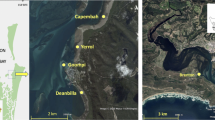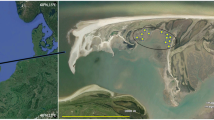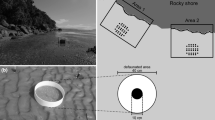Abstract
Shape is considered an important attribute of patches, but little attention has been paid to its influence on the structure and dynamics of rocky shore assemblages. Effects of patch shape were investigated from September 1997 to June 1998 in algal assemblages on intertidal shores at Cape Banks, south of Sydney (NSW, Australia). Three experiments were established, in order to separately investigate the importance of three different characteristics of patch shape, namely area, perimeter and distance of the central zone from the edge. In each experiment, responses for sets of replicate patches that differed on average for only one shape characteristic were compared. Patches of different shapes were produced by scraping off all resident organisms, and subsequent colonisation was recorded. The range of shapes naturally occurring at the study sites was also measured over 1 year, and the shapes of plots used in the experiments were chosen to cover this range of natural variability. Shapes of natural patches within assemblages were very variable. Consistent differences were observed in patch size, geometry and characteristics of the substratum among sheltered and exposed shores and among different times of the year, suggesting that different disturbances influence the dynamics of assemblages at these sites. The results of the three experiments showed that shape may have important effects on patch colonisation. Area, perimeter and distance of the central zone from the edge significantly affected growth of algae in experimental clearings. Responses to different patch characteristics were species specific. Effects of different attributes of patch shape also varied over time. This spatial and temporal variability of responses suggests that colonisation processes of patches of different shapes are complex, probably involving effects that can produce contrasting results. Results are relevant to the design and interpretation of field experiments, as they suggest that the shape of plots may affect the perception of patterns and processes in intertidal assemblages.






Similar content being viewed by others
References
Airoldi L (1998) Roles of disturbance, sediment stress, and substratum retention on spatial dominance in algal turf. Ecology 79:2759–2770
Airoldi L (2000a) Responses of algae with different life histories to temporal and spatial variability of disturbance in subtidal reefs. Mar Ecol Prog Ser 195:81–92
Airoldi L (2000b) Effects of disturbance, life histories, and overgrowth on coexistence of algal crusts and turfs. Ecology 81:798–814
Airoldi L (2003) The effects of sedimentation on rocky coast assemblages. Oceanogr Mar Biol Annu Rev 41:161–236
Airoldi L, Virgilio M (1998) Responses of turf-forming algae to spatial variations in the deposition of sediments. Mar Ecol Prog Ser 165:271–282
Anderson MJ (1998) Effects of patch size on colonisation in estuaries: revisiting the species–area relationship. Oecologia 118:87–98
Benedetti-Cecchi L, Cinelli F (1994) Recovery of patches in an assemblage of geniculate coralline algae: variability at different successional stages. Mar Ecol Prog Ser 110:9–18
Benedetti-Cecchi L, Airoldi L, Abbiati M, Cinelli F (1996) Estimating the abundance of benthic invertebrates: a comparison of procedures and variability between observers. Mar Ecol Prog Ser 138:93–101
Chapman MG, Underwood AJ (1998) Inconsistency and variation in the development of rocky intertidal algal assemblages. J Exp Mar Biol Ecol 224:265–289
Connell JH, Keough MJ (1985) Disturbance and patch dynamics of subtidal marine animals on hard substrata. In: Pickett STA, White PS (eds) The ecology of natural disturbance and patch dynamics. Academic, London, pp 125–151
Dayton PK (1971) Competition, disturbance, and community organization: the provision and subsequent utilization of space in a rocky intertidal community. Ecol Monogr 41:351–389
Dye AH (1993) Recolonisation of intertidal macroalgae in relation to gap size and molluscan herbivory on a rocky shore on the east coast of southern Africa. Mar Ecol Prog Ser 95:263–271
Farina A (1998) Principles and methods in landscape ecology. Chapman and Hall, London
Farrell TM (1989) Succession in a rocky intertidal community: the importance of disturbance size and position within a disturbed patch. J Exp Mar Biol Ecol 128:57–73
Fraschetti S, Bianchi CN, Terlizzi A, Fanelli G, Morri C, Boero F (2001) Spatial variability and human disturbance in shallow subtidal hard substrate assemblages: a regional approach. Mar Ecol Prog Ser 212:1–12
Game M (1980) Best shapes for nature reserves. Nature 287:630–631
Gutzwiller KJ, Anderson SH (1992) Interception of moving organisms: influences of patch shape, size, and orientation on community structure. Landsc Ecol 6:293–303
Hamazaki T (1996) Effects of patch shape on the number of organisms. Landsc Ecol 11:299–306
Harper S, Bollinger EK, Barrett G (1993) Effects of habitat patch shape on population dynamics of meadow voles (Microtus pennsylvanicus). J Mammal 74:1045–1055
Hawkins SJ (1981) The influence of season and barnacles on the algal colonisation of Patella vulgata exclusion areas. J Mar Biol Assoc UK 61:1–15
Hawkins SJ, Hartnoll RG (1983) Grazing of intertidal algae by marine invertebrates. Oceanogr Mar Biol Annu Rev 21:195–282
Helzer CJ, Jelinski DE (1999) The relative importance of patch area and perimeter–area ratio to grassland breeding birds. Ecol Appl 9:1448–1458
Jackson JBC (1977) Habitat area, colonization, and development of epibenthic community structure. In: Keegan BF, O'Ceidigh P, Boaden PJS (eds) Biology of benthic organisms. Pergamon, New York, pp 349–358
Johnson MP, Burrows MT, Hartnoll RG, Hawkins SJ (1997) Spatial structure on moderately exposed rocky shores: patch scales and the interactions between limpets and algae. Mar Ecol Prog Ser 160:209–215
Keough MJ (1984) Effects of patch size on the abundance of sessile marine invertebrates. Ecology 65:423–437
Keough MJ, Quinn GP (1998) Effects of periodic disturbances from trampling on rocky intertidal algal beds. Ecol Appl 8:141–161
Kim JH, DeWreede RE (1996) Effects of patch size and season of disturbance on algal patch recovery in a rocky intertidal community. Mar Ecol Prog Ser 133:217–228
Kingsford MJ, Underwood AJ, Kennelly SJ (1991) Humans as predators on rocky reefs in New South Wales, Australia. Mar Ecol Prog Ser 72:1–14
Krummel JR, Gardner RH, Sugihara G, O'Neill RV, Coleman PR (1987) Landscape patterns in a disturbed environment. Oikos 48:321–324
Littler MM, Littler DS (1984) Relationship between macroalgal functional form groups and substrata stability in a subtropical rocky-intertidal system. J Exp Mar Biol Ecol 74:13–34
McCook LJ, Chapman ARO (1997) Patterns and variations in natural succession following massive ice-scour of a rocky intertidal seashore. J Exp Mar Biol Ecol 214:121–147
Menge BA (1976) Organization of the New England rocky intertidal community: role of predation, competition, and environmental heterogeneity. Ecol Monogr 46:355–393
Menge BA, Farrell TM, Olson AM, van Tamelen P, Turner T (1993) Algal recruitment and the maintenance of a plant mosaic in the low intertidal region on the Oregon coast. J Exp Mar Biol Ecol 170:91–116
Minchinton TE (1997) Life on the edge: conspecific attraction and recruitment of populations to disturbed habitats. Oecologia 111:45–52
Moreno CA (2001) Community patterns generated by human harvesting on Chilean shores. Aquat Conserv: Mar Freshw Ecosyst 11:19–30
Navarrete SA, Castilla JC (1990) Barnacle walls as mediators of intertidal mussel recruitment: effects of patch size on the utilization of space. Mar Ecol Prog Ser 68:113–119
Oren U, Benayahu Y, Loya Y (1997) Effect of lesion size and shape on regeneration of the Red Sea coral Favia favus. Mar Ecol Prog Ser 146:101–107
Osman R (1977) The establishment and development of a marine epifaunal community. Ecol Monogr 47:37–63
Paine RT, Levin SA (1981) Intertidal landscapes: disturbance and the dynamics of patterns. Ecol Monogr 51:145–178
Palumbi SR, Jackson JBC (1981) Ecology of cryptic coral reef communities. II. Recovery from small disturbance events by encrusting Bryozoa: the influence of "host" species and lesion size. J Exp Mar Biol Ecol 64:103–115
Pickett STA, White PS (1985) The ecology of natural disturbance and patch dynamics. Academic, London
Raimondi PT (1990) Patterns, mechanisms, consequences of variability in settlement and recruitment of an intertidal barnacle. Ecol Monogr 60:283–309
Shorrocks B, Swingland IR (1990) Living in a patchy environment. Oxford University Press, Oxford
Short AD, Trenaman NL (1992) Wave climate of the Sydney region, an energetic and highly variable ocean regime. Aust J Mar Freshw Res 43:765–791
Sousa WP (1979) Experimental investigations of disturbance and ecological succession in a rocky intertidal algal community. Ecol Monogr 49:227–254
Sousa WP (1984a) Intertidal mosaics: patch size, propagule availability, and spatially variable patterns of succession. Ecology 65:1918–1935
Sousa WP (1984b) The role of disturbance in natural communities. Annu Rev Ecol Syst 15:353–391
Sousa WP (1985) Disturbance and patch dynamics on rocky intertidal shores. In: Pickett STA, White PS (eds) The ecology of natural disturbance and patch dynamics. Academic, London, pp 101–124
Sousa WP (2001) Natural disturbance and the dynamics of marine benthic communities. In: Bertness MD, Gaines SD, Hay ME (eds) Marine community ecology. Sinauer, Sunderland, Mass., pp 85–130
Southward AJ (1964) Limpet grazing and the control of vegetation on rocky shores. In: Crisp DJ (ed) Grazing in terrestrial and marine environments. Blackwell, Oxford, pp 265–273
Underwood AJ (1980) The effects of grazing by gastropods and physical factors on the upper limits of distribution of intertidal macroalgae. Oecologia 46:201–213
Underwood AJ (1997) Experiments in ecology. Their logical design and interpretation using analysis of variance. Cambridge University Press, Cambridge
Underwood AJ, Chapman MG (1998) Variation in algal assemblages on wave-exposed rocky shores in New South Wales. Mar Freshw Res 49:241–254
Whittaker RH, Levin SA (1977) The role of mosaic phenomena in natural communities. Theor Popul Biol 12:117–139
Wiens JA (1976) Population responses to patchy environments. Annu Rev Ecol Syst 7:81–120
Williams GA (1993) Seasonal variation in algal species richness and abundance in the presence of molluscan herbivores on a tropical rocky shore. J Exp Mar Biol Ecol 167:261–275
Acknowledgements
The research was supported by funding of the Australian Research Council to A. J. Underwood, by funds from the Centre for Research on Ecological Impacts of Coastal Cities, and by a postdoctoral grant (Assegno di Ricerca) of the University of Bologna to L. Airoldi, the latter while writing the paper. I wish to thank M.W. Beck, T.M. Glasby, A.J. Underwood and an anonymous referee for their careful reviews of the manuscript and important suggestions. I wish to thank A.J. Underwood for the initiatives and concepts on which the project was based, and the idea that different components of shape should be examined separately. I also wish to thank S. Neal, M. Abbiati and J. Cunningam for assistance with the field work, A. Millar for help with the identification of algae and V.U. Ceccherelli who provided space and facilities at the Centro Interdipartimentale di Ricerca per le Scienze Ambientali in Ravenna of the Università di Bologna. I am particularly grateful to S. Neal for sharing many hours of hard work and for her friendly encouragement, and to V. Nonni for her invaluable assistance and support to pursue my work.
Author information
Authors and Affiliations
Corresponding author
Additional information
Communicated by R. Cattaneo-Vietti, Genova
Rights and permissions
About this article
Cite this article
Airoldi, L. Effects of patch shape in intertidal algal mosaics: roles of area, perimeter and distance from edge. Marine Biology 143, 639–650 (2003). https://doi.org/10.1007/s00227-003-1119-3
Received:
Accepted:
Published:
Issue Date:
DOI: https://doi.org/10.1007/s00227-003-1119-3




